The Coastal Battleships: This type of “pocket” battleship existed in any second or third-rate navy alongside torpedo boats for shoreline self-defense purposes. Still wielding relatively big guns and decent armour, they were a potent deterrent in 1914. But in the 1890s they were the cornerstone of the Austro-Hungarian Navy. The Monarch class has been the first to use proper turrets instead of barbettes. In the end, they would serve through the duration of WW1.
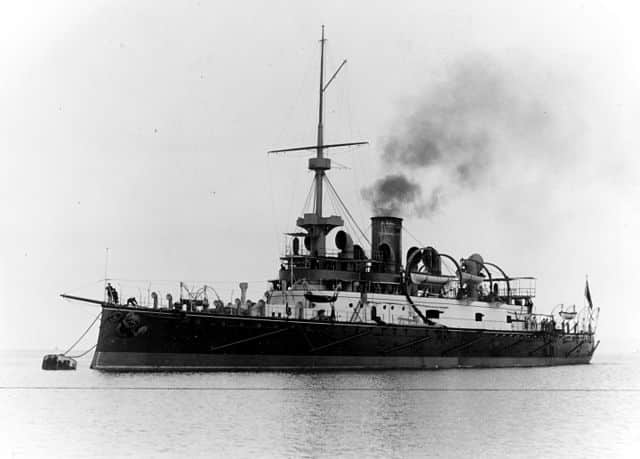
SMS Wien before the war
Development history
By 1890, SMS Kronprinz Erzherzog Rudolf and SMS Kronprinzessin Erzherzogin Stephanie were former sail ironclads dating back from the 1870s, and although modernized, they were hopelessly outmatched, in particular by Brin’s Italian battleships in the 1880s. By 1893, funds were available to build three new battleships, but the Hungarian and Austrian parliaments only authorized coastal defense ships according to the naval policy of the day. After a classification change to “Coastal Battleship”, the new ships were named Budapest, Wien, and Monarch. They were the brainchild of the newly appointed director of naval construction, Siegfried Popper. The first two were built at Stabilimento Tecnico Triestino yards in Trieste and the Monarch at Naval Arsenal in Pola. They were laid down in 1893, launched in 1895-96, and commissioned in 1897-98.
Design
The three ships’ displacement was about 5,878 tonnes (5,785 long tons), making them early “pocket battleships”. Their armament was not negligible though, with four turreted 240 mm (9 in) L/40 guns, six individual casemate 150 mm (6 in) L/40 guns, ten 47 mm (1.9 in) L/44 and four L/33 guns, alongside one 8 mm (0.31 in) MG gun and four torpedo tubes. Later in the war, in 1917, a Škoda 7 cm K16 anti-aircraft gun was added to SMS Monarch’s sisters, while she received an older L/45 BAG.
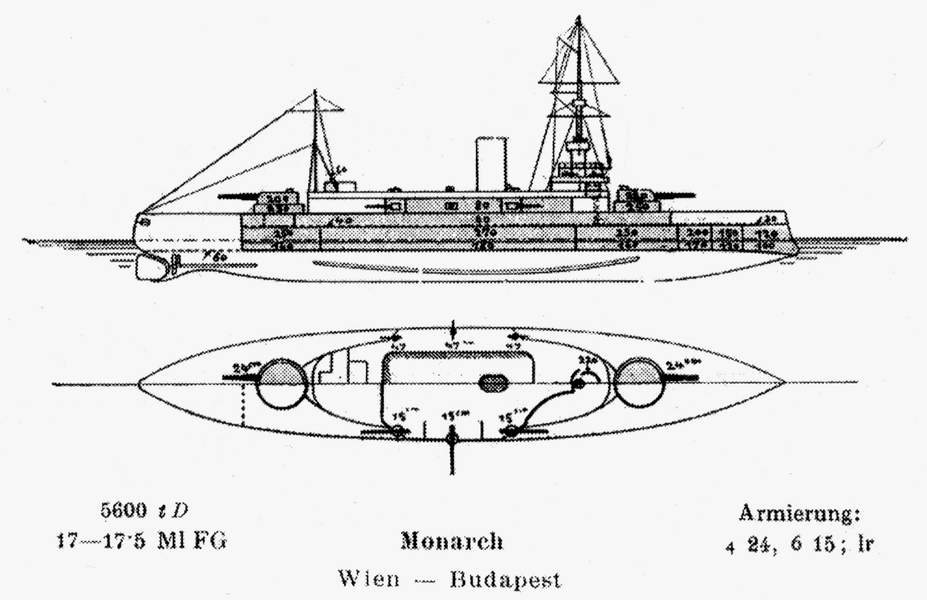
Brassey’s diagram of the Monarch class
All three ships were fitted with Harvey armour. Their belt armor thickness was 270 mm (11 in), their turrets were 203 mm (8.0 in) thick, their conning towers 220 mm (8.7 in), decks 64 mm (2.5 in), and the redoubt and casemates 76 mm (3.0 in) of thickness. Their complement consisted of 26 officers and 397 sailors, with 423 personnel total per ship.
The propulsion varied by ship. Budapest used 12 coal-fired Belleville boilers without economizers, giving an output of 9,180 hp (6,846 kW) for a top speed of 17.5 knots (32.4 km/h; 20.1 mph). Wien and Monarch had coal-fired cylindrical boilers and vertical triple expansion engines giving them 8,500 hp (6,338 kW) for a maximum speed of 15.5 knots (28.7 km/h; 17.8 mph). Monarch-class ships normally carried 300 tons of coal, with a maximum of 500 tons, for a range of about 2,200 nmi (4,100 km), quite sufficient for extended raids in the Adriatic.
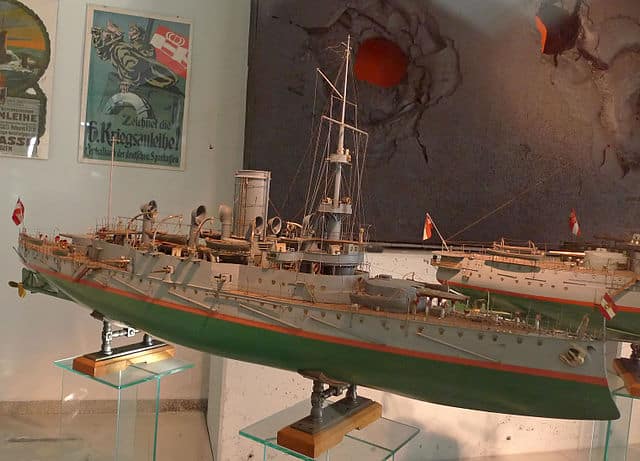
Model of the Budapest
Service History
Soon after being commissioned, the Budapest, Monarch, and Wien began a cruise around the Adriatic and Aegean in 1899 to display the flag in foreign waters, as the 1st Battleship Division. Early on, Wien participated in the Diamond Jubilee of the crowning of Queen Victoria in 1897 and the international blockade off Crete during the Greco-Turkish War of 1897.
The newly completed SMS Habsburg conducted a training cruise with the three Monarch-class battleships in January 1903, and the next year, they were joined by the SMS Árpád. Eventually, the three Habsburg-class battleships engaged the three Monarchs in simulated combat. The three new ships also were given the 1st Battleship Division while the three Monarch were versed into the newly created 2nd battleship division, which was changed to the IIIrd, IVth, and the Vth with the arrival of the Erzherzog Karl and Radetzky classes.
In 1914, the Monarch class served as coastal defense ships, training ships, and bombarded coastal positions during the early years of the war: Budapest was transferred to Cattaro to shell Mount Lovcen, Monarch shelled the French radio station at Budva, Montenegrin radio station off Bar, as well as the barracks and radio HQ at Volovica Point in August. On 28–29 December 1915 Budapest participated in the aborted raid on Durazzo. In January 1916, Budapest shelled fortifications on Mount Lovcen, helping capture the city while Monarch and Wien shelled Italian troops in the Gulf of Trieste.
However, the latter was torpedoed on 10 December 1917, by two Italian boats which managed to penetrate the port of Trieste undetected. Wien was hit twice and sank in less than five minutes with forty-six men going down with her. Her executioner was MAS 9, manned by Luigi Rizzo (He also sank the Szent Istvan) who became a national hero at home. Budapest was demoted to a floating barrack for German U-boat crews, but in June 1918 she received a 380 mm (15 in) L/17 howitzer in her bow for coastal bombardment, which was never used. The Monarch was anchored at Cattaro when in February 1918 a mutiny took place on board. The two ships were handed over to Great Britain as war reparations and left to the UK which sold her to be broken up in Italy in 1920 and 1922. In 1914 replacements were planned, the Ersatz Monarch-class, which were improved Tegetthoff class dreadnoughts.
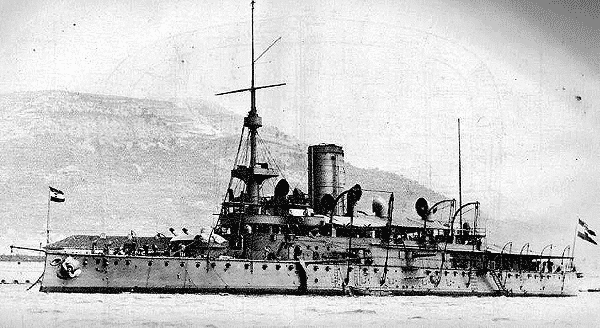
The SMS Monarch during the war
Links and sources
The Monarch class on wikipedia
3D versions on viribus-unitis.ca
On battleships-cruisers.co.uk
Index of ww1 Austro-Hungarian ships
Conway’s all the world fighting ships 1865-1905
Monarch specifications |
|
| Dimensions | 99,2 x 17 x 6,6 m (325 x 55 x 22ft) |
| Displacement | 5800 t FL |
| Crew | 469 |
| Propulsion | 2 screws, 2 TE 3 cyl., 12 boilers, 8500-9000 hp |
| Speed | 15,5-17 knots (32.4 km/h; 20.1 mph Budapest) |
| Range | 2,200 nmi (4100 km) at cruise speed |
| Armament | 4 x 240, 6 x 150, 1 x 70AA, 10 x 47, 4 x 37, 4 TT 445 mm SM (ft, rear, sides) |
| Armor | Turrets 280, Casemate 76, Belt 270, Blockhaus 220, Deck 60 mm |
Gallery
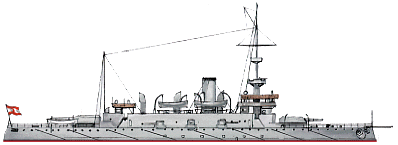
Illustration of the Monarch – 1/730
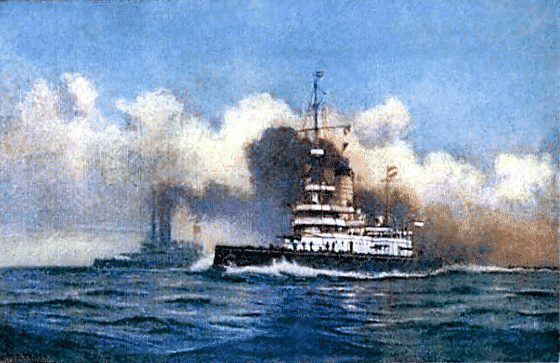
Painting of the SMS Wien


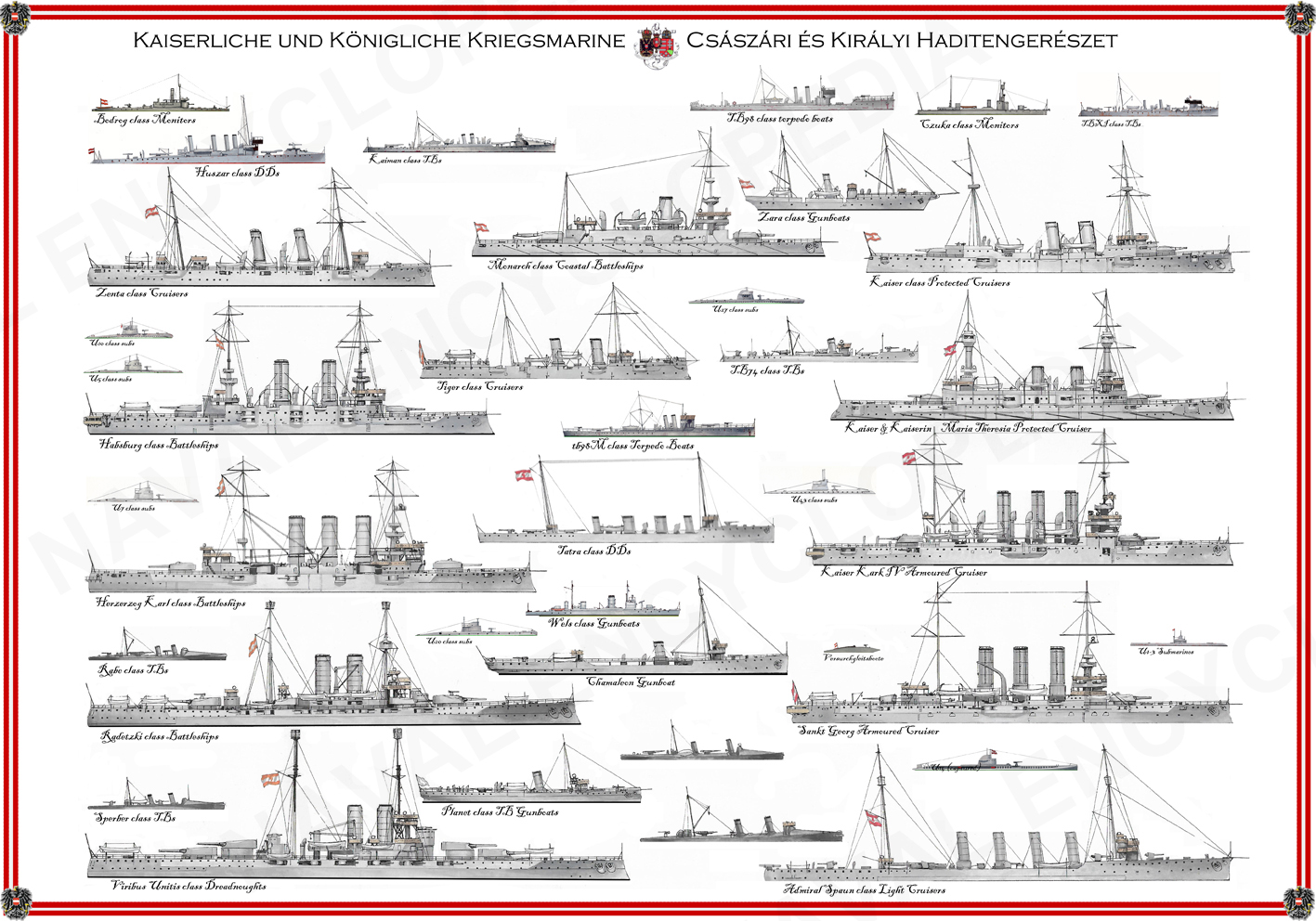
 Latest Facebook Entry -
Latest Facebook Entry -  X(Tweeter) Naval Encyclopedia's deck archive
X(Tweeter) Naval Encyclopedia's deck archive Instagram (@navalencyc)
Instagram (@navalencyc)





 French Navy
French Navy Royal Navy
Royal Navy Russian Navy
Russian Navy Armada Espanola
Armada Espanola Austrian Navy
Austrian Navy K.u.K. Kriegsmarine
K.u.K. Kriegsmarine Dansk Marine
Dansk Marine Nautiko Hellenon
Nautiko Hellenon Koninklije Marine 1870
Koninklije Marine 1870 Marinha do Brasil
Marinha do Brasil Osmanlı Donanması
Osmanlı Donanması Marina Do Peru
Marina Do Peru Marinha do Portugal
Marinha do Portugal Regia Marina 1870
Regia Marina 1870 Nihhon Kaigun 1870
Nihhon Kaigun 1870 Preußische Marine 1870
Preußische Marine 1870 Russkiy Flot 1870
Russkiy Flot 1870 Svenska marinen
Svenska marinen Søværnet
Søværnet Union Navy
Union Navy Confederate Navy
Confederate Navy Armada de Argentina
Armada de Argentina Imperial Chinese Navy
Imperial Chinese Navy Marinha do Portugal
Marinha do Portugal Mexico
Mexico Kaiserliche Marine
Kaiserliche Marine 1898 US Navy
1898 US Navy Sovietskiy Flot
Sovietskiy Flot Royal Canadian Navy
Royal Canadian Navy Royal Australian Navy
Royal Australian Navy RNZN Fleet
RNZN Fleet Chinese Navy 1937
Chinese Navy 1937 Kriegsmarine
Kriegsmarine Chilean Navy
Chilean Navy Danish Navy
Danish Navy Finnish Navy
Finnish Navy Hellenic Navy
Hellenic Navy Polish Navy
Polish Navy Romanian Navy
Romanian Navy Turkish Navy
Turkish Navy Royal Yugoslav Navy
Royal Yugoslav Navy Royal Thai Navy
Royal Thai Navy Minor Navies
Minor Navies Albania
Albania Austria
Austria Belgium
Belgium Columbia
Columbia Costa Rica
Costa Rica Cuba
Cuba Czechoslovakia
Czechoslovakia Dominican Republic
Dominican Republic Haiti
Haiti Hungary
Hungary Honduras
Honduras Estonia
Estonia Iceland
Iceland Eire
Eire Equador
Equador Iran
Iran Iraq
Iraq Latvia
Latvia Liberia
Liberia Lithuania
Lithuania Mandchukuo
Mandchukuo Morocco
Morocco Nicaragua
Nicaragua Persia
Persia San Salvador
San Salvador Sarawak
Sarawak Uruguay
Uruguay Venezuela
Venezuela Zanzibar
Zanzibar Warsaw Pact Navies
Warsaw Pact Navies Bulgaria
Bulgaria Hungary
Hungary

 Bundesmarine
Bundesmarine Dutch Navy
Dutch Navy Hellenic Navy
Hellenic Navy Marina Militare
Marina Militare Yugoslav Navy
Yugoslav Navy Chinese Navy
Chinese Navy Indian Navy
Indian Navy Indonesian Navy
Indonesian Navy JMSDF
JMSDF North Korean Navy
North Korean Navy Pakistani Navy
Pakistani Navy Philippines Navy
Philippines Navy ROKN
ROKN Rep. of Singapore Navy
Rep. of Singapore Navy Taiwanese Navy
Taiwanese Navy IDF Navy
IDF Navy Saudi Navy
Saudi Navy Royal New Zealand Navy
Royal New Zealand Navy Egyptian Navy
Egyptian Navy South African Navy
South African Navy






























 Ukrainian Navy
Ukrainian Navy dbodesign
dbodesign